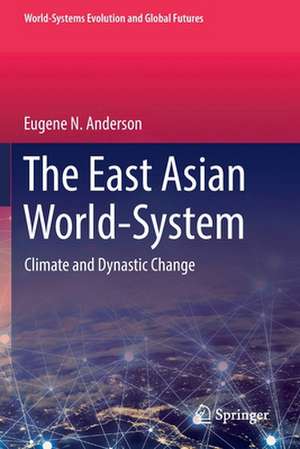The East Asian World-System: Climate and Dynastic Change: World-Systems Evolution and Global Futures
Autor Eugene N. Andersonen Limba Engleză Paperback – 15 aug 2020
| Toate formatele și edițiile | Preț | Express |
|---|---|---|
| Paperback (1) | 452.62 lei 43-57 zile | |
| Springer International Publishing – 15 aug 2020 | 452.62 lei 43-57 zile | |
| Hardback (1) | 588.50 lei 43-57 zile | |
| Springer International Publishing – 14 iun 2019 | 588.50 lei 43-57 zile |
Din seria World-Systems Evolution and Global Futures
- 15%
 Preț: 636.45 lei
Preț: 636.45 lei - 18%
 Preț: 783.20 lei
Preț: 783.20 lei - 18%
 Preț: 783.20 lei
Preț: 783.20 lei - 15%
 Preț: 698.30 lei
Preț: 698.30 lei - 18%
 Preț: 733.15 lei
Preț: 733.15 lei - 15%
 Preț: 657.08 lei
Preț: 657.08 lei - 15%
 Preț: 643.16 lei
Preț: 643.16 lei - 18%
 Preț: 1125.86 lei
Preț: 1125.86 lei -
 Preț: 381.00 lei
Preț: 381.00 lei - 18%
 Preț: 1107.73 lei
Preț: 1107.73 lei - 18%
 Preț: 1104.43 lei
Preț: 1104.43 lei - 15%
 Preț: 636.80 lei
Preț: 636.80 lei - 24%
 Preț: 676.83 lei
Preț: 676.83 lei - 18%
 Preț: 789.20 lei
Preț: 789.20 lei - 18%
 Preț: 1017.62 lei
Preț: 1017.62 lei - 9%
 Preț: 664.87 lei
Preț: 664.87 lei
Preț: 452.62 lei
Nou
Puncte Express: 679
Preț estimativ în valută:
86.61€ • 90.66$ • 72.09£
86.61€ • 90.66$ • 72.09£
Carte tipărită la comandă
Livrare economică 31 martie-14 aprilie
Preluare comenzi: 021 569.72.76
Specificații
ISBN-13: 9783030168728
ISBN-10: 3030168727
Pagini: 248
Ilustrații: XII, 248 p. 6 illus.
Dimensiuni: 155 x 235 mm
Greutate: 0.37 kg
Ediția:1st ed. 2019
Editura: Springer International Publishing
Colecția Springer
Seria World-Systems Evolution and Global Futures
Locul publicării:Cham, Switzerland
ISBN-10: 3030168727
Pagini: 248
Ilustrații: XII, 248 p. 6 illus.
Dimensiuni: 155 x 235 mm
Greutate: 0.37 kg
Ediția:1st ed. 2019
Editura: Springer International Publishing
Colecția Springer
Seria World-Systems Evolution and Global Futures
Locul publicării:Cham, Switzerland
Cuprins
Theoretical Overview.- Cycles and Cycling.- Before Empire: State Formation in China and Proto-states Elsewhere.- The Creation of Stable Dynastic Empires in East and Southeast Asia.- High Empire: The Glory Days of Early Medieval Eastern Asia.- The Rise of Central Asia: Coastal Golden Ages Increasingly Threatened by Conquest Dynasties from the Deep Interior.- The Mongol Conquests of China and Korea and Invasion of Japan.- Long-lived Dynasties: Ming and Its Contemporaries.- The Early Modern Period in the East Asian World-System.- Lessons: Factors Driving the Rise and Fall of Dynasties.- Comparisons: Cycles and Empires in Agrarian Worlds.- What East Asia's Dynamics Teach Us about Climate, Society, and Change in the Modern and Future World.
Notă biografică
E. N. Anderson is Professor of Anthropology, Emeritus, at the University of California, Riverside. He received his Ph.D. in anthropology from the University of California, Berkeley, in 1967. He has done research on ethnobiology, cultural ecology, political ecology, and medical anthropology, in several areas, especially Hong Kong, British Columbia, California, and the Yucatan Peninsula of Mexico. His books include The Food of China (Yale University Press. 1988), Ecologies of the Heart (Oxford University Press, 1996), The Pursuit of Ecotopia (Praeger, 2010), Caring for Place (2014), Everyone Eats (2014), Food and Environment in Early and Medieval China (2014), and, with Barbara A. Anderson, Warning Signs of Genocide (2012). He has five children and five grandchildren. He lives in Riverside, California, with his wife Barbara Anderson and three dogs.
Textul de pe ultima copertă
This book studies the East Asian world-system and its dynastic cycles as they were influenced by climate and demographic change, diseases, the expansion of trade, and the rise of science and technology. By studying the history of East Asia until the beginning of the 20th century and offering a comparative perspective on East Asian countries, including China, Japan and Korea, it describes the historical evolution of the East Asian world-system as being the result of good or poor management of the respective populations and environments. Lastly, the book discusses how the East Asian regions have become integrated into a single world-system by a combination of trade, commerce, and military action. Given its scope, the book will appeal to scholars of history, sociology, political science and environmental studies, and to anyone interested in learning about the effects of climate change on the dynamic development of societies.
Caracteristici
Studies the East Asian world-system and its dynastic cycles Highlights the effects of climate change on East Asian history Presents cyclic theories of history to describe dynastic cycles
